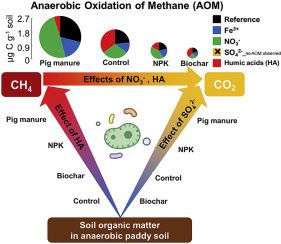Soil Biology and Biochemistry ( IF 9.7 ) Pub Date : 2019-11-22 , DOI: 10.1016/j.soilbio.2019.107685 Lichao Fan , Michaela A. Dippold , Tida Ge , Jinshui Wu , Volker Thiel , Yakov Kuzyakov , Maxim Dorodnikov

|
The anaerobic oxidation of methane (AOM) in marine ecosystems is ubiquitous and largely coupled to sulfate reduction. In contrast, the role of AOM in terrestrial environments and the dominant electron acceptors driving terrestrial AOM needs deeper understanding. Submerged rice paddies with intensive CH4 production have a high potential for AOM, which can be important for greenhouse gas mitigation strategies. Here, we used 13CH4 to quantify the AOM rates in paddy soils under organic (Pig manure, Biochar) and mineral (NPK) fertilization. Alternative-to-oxygen electron acceptors for CH4 oxidation, including Fe3+, NO3−, SO42−, and humic acids, were examined and their potential for CH4 mitigation from rice paddies was assessed by 13CH4 oxidation to 13CO2 under anoxic conditions.
During 84 days of anaerobic incubation, the cumulative AOM (13CH4-derived CO2) reached 0.15–1.3 μg C g-1 dry soil depending on fertilization. NO3- was the most effective electron acceptor, yielding an AOM rate of 0.80 ng C g-1 dry soil h-1 under Pig manure. The role of Fe3+ in AOM remained unclear, whereas SO42- inhibited AOM but strongly stimulated the production of unlabeled CO2, indicating intensive sulfate-induced decomposition of organic matter. Humic acids were the second most effective electron acceptor for AOM, but increased methanogenesis by 5–6 times in all fertilization treatments. We demonstrated for the first time that organic electron acceptors (humic acids) are among the key AOM drivers and are crucial in paddy soils. The most pronounced AOM in paddy soils occurred under Pig manure, followed by Control and NPK, while AOM was the lowest under Biochar. We estimate that nitrate (nitrite)-dependent AOM in paddy fields globally consumes ~3.9 Tg C–CH4 yr-1, thereby offsetting the global CH4 emissions by ~10–20%. Thus, from a broader agroecological perspective, the organic and mineral fertilizers control an important CH4 sink under anaerobic conditions in submerged ecosystems. Appropriate adjustments of soil fertilization management strategies would therefore help to decrease the net CH4 flux to the atmosphere and hence the global warming.
中文翻译:

稻田甲烷的厌氧氧化:电子受体和施肥在缓解CH 4通量方面的作用
海洋生态系统中甲烷的厌氧氧化是普遍存在的,并且在很大程度上与硫酸盐的还原有关。相反,AOM在地面环境中的作用以及驱动地面AOM的主要电子受体需要深入理解。大量生产CH 4的淹没稻田有很高的AOM潜力,这对于减少温室气体排放策略可能很重要。在这里,我们使用13 CH 4来量化有机(猪粪,Biochar)和矿物(NPK)施肥下稻田土壤的AOM速率。替代与氧的电子受体为CH 4氧化,含有Fe 3+,NO 3 -,SO 4 2-,和腐殖酸,检查以及它们用于CH潜在4从稻田减缓通过评估13 CH 4氧化成13 CO 2缺氧条件下。
在厌氧培养的84天中,取决于施肥情况,累积的AOM(13CH4衍生的CO2)达到0.15–1.3μgC g-1干燥土壤。NO3-是最有效的电子受体,在猪粪下的AOM值为0.80 ng C g-1干燥土壤h-1。Fe3 +在AOM中的作用仍不清楚,而SO42-抑制AOM但强烈刺激了未标记的CO2的产生,表明硫酸盐引起的有机物的强烈分解。腐殖酸是AOM的第二大最有效的电子受体,但是在所有的施肥处理中,产甲烷率提高了5-6倍。我们首次证明了有机电子受体(腐殖酸)是AOM的关键驱动力,并且在稻田土壤中起着至关重要的作用。稻田土壤中最明显的AOM发生在猪粪下,其次是对照和NPK,而AOM是Biochar之下最低的。我们估计,全球稻田中依赖硝酸盐(亚硝酸盐)的AOM消耗约3.9 Tg C–CH4 yr-1,从而使全球CH4排放量抵消了约10–20%。因此,从更广泛的农业生态学角度来看,有机和矿物肥料可在淹没的生态系统中的厌氧条件下控制重要的CH4汇。因此,适当调整土壤肥料管理策略将有助于减少向大气中排放的CH4净通量,从而减少全球变暖。在水下生态系统中,有机和矿物肥料可在厌氧条件下控制重要的CH4汇。因此,适当调整土壤肥料管理策略将有助于减少向大气中排放的CH4净通量,从而减少全球变暖。在水下生态系统中,有机和矿物肥料可在厌氧条件下控制重要的CH4汇。因此,适当调整土壤施肥管理策略将有助于减少向大气中排放的CH4净通量,从而减少全球变暖。



























 京公网安备 11010802027423号
京公网安备 11010802027423号